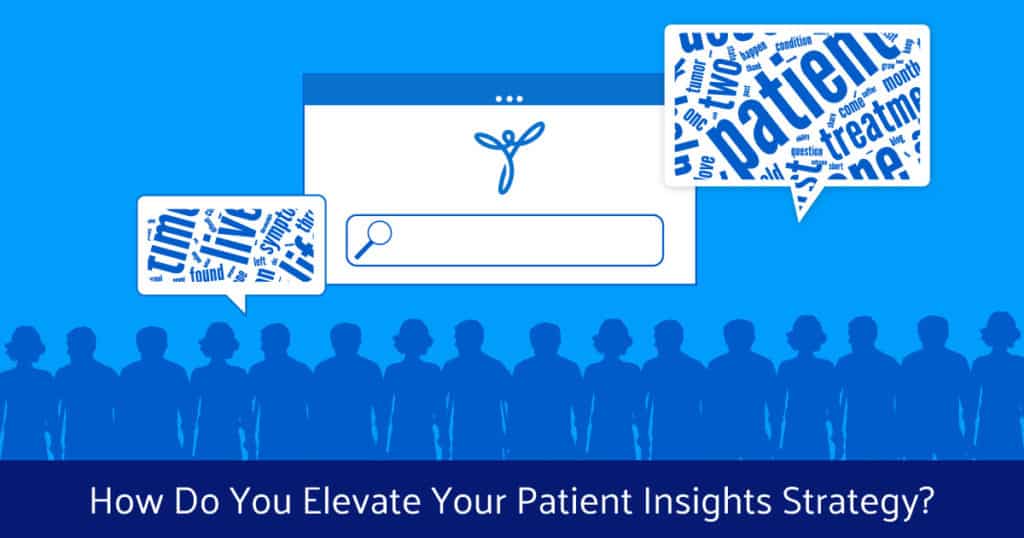How Do You Elevate Your Patient Insights Strategy?

You know what you want to say about your product, but are you still looking for the right way to say it? Successful DTC advertising relies on finding language that resonates with target patients. A recent study demonstrated just how profoundly a choice of words affects patient treatment decisions.
A survey cited in the JAMA in March showed that 400 ductal carcinoma in situ (DCIS) patients chose different theoretical treatments based on descriptions alone. When DCIS is presented as “abnormal cells,” 69% of the group preferred “watchful waiting,” but when the diagnosis was presented as “non-invasive cancer,” 53% chose treatment.1
Clearly, word choice matters. Ordinarily, market testing relies on focus groups and ATU studies, but timing is critical: According to a recent webcast,2 this year’s successful pharma launches depended on a quick pivot to digital tools when the pandemic emerged. The presenters emphasized “flexibility and agility” as keys to success, and were enthusiastic about implementing digital tools such as quickly implemented “pulse ATU” surveys.
They also emphasized market preparation, but it too must be timely; word choices matter in all social subgroups, and can change rapidly.3 Social media is a rich and representative source of current-use patient language. In fact, a systematic review of 21 studies using Natural Language Processing (NLP) analysis and data mining studies of electronic patient-authored text (ePAT) concluded that understanding patient-authored text is critical to understanding the experience of the patient.4
Taking advantage of real time and real world patient language offers benefits over relying on past experience or on traditionally fielded focus groups, both of which are unreliable in an environment requiring concurrent responses to changes. Appropriate use of patient languagebased on careful market studies can differentiate your product from its competitors, but it takes expertise.
For example, in one study Inspire conducted for a client, words like “hope”, “survivor” and “survival” had different expectations and connotations for patients with cancer based on age, life stage, and experience with their condition.
In those findings, younger members focused on hope and living a “normal” lifespan. As they aged, members tempered their expectations, concentrating on shorter time frames and reaching major life milestones. Inspire’s sociolinguists identified words and language to use with extreme caution in any messaging around overall survival for each of the age/lifestage groups.5
Inspire can field a sociolinguistic analysis of unstructured communications between patients rapidly, and fine-tune results with products such as virtual focus groups or virtual patient/caregiver interviews. The results provide comprehensive instructions on the messaging that should be used, the words that can backfire, and the subtle audience differences that can alter a marketing team’s approach to sensitive subjects. Such studies also reveal the real-time changes in language use in different groups of patients.
See this week, read more about how language affects patient reactions in Inspire’s new case study: “Insights from Patients with Stage IV Cancer Aid Product Marketing.”
Inspire offers a trusted community to patients and caregivers. Our goal with this blog, this website and our content is to provide the life science industry access to the true, authentic patient voice. In so doing, we support faithful operationalization of patient-centricity. Take a look at our case studies, eBooks and news outlet coverage.
References:
1 Morgan, D. et al. “Improving Physician Communication about Treatment Decisions.” JAMA. 2020;324(10):937-938. doi:10.1001/jama.2020.0354. March 9, 2020
2See the Patient Pulse blog from 10/27/2020, https://corp.inspire.com/blog/launching-a-new-drug-during-a-pandemic/
3 See our eBook “How Does Pharma Lean to Speak ‘Patient’” Vol. II for a cautionary tale.
4Dreisbach, C. et al. “A systematic review of natural language processing and text mining of symptoms from electronic patient-authored text data.” International Journal of Medical Informatics. Vol. 125 May 2019
5 Inspire. Avoiding Pitfalls: Using Patient Insights from Social Media for Product Marketing. https://corp.inspire.com/resource/avoiding-pitfalls-social-media-product-marketing/






